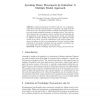Free Online Productivity Tools
i2Speak
i2Symbol
i2OCR
iTex2Img
iWeb2Print
iWeb2Shot
i2Type
iPdf2Split
iPdf2Merge
i2Bopomofo
i2Arabic
i2Style
i2Image
i2PDF
iLatex2Rtf
Sci2ools
KI
2008
Springer
2008
Springer
Learning Dance Movements by Imitation: A Multiple Model Approach
Abstract. Imitation learning is an intuitive and easy way of programming robots. Instead of specifying motor commands, you simply show the robot what to do. This paper presents a modular connectionist architecture that enables imitation learning in a simulated robot. The robot imitates human dance movements, and the architecture self-organizes the decomposition of movements into submovements, which are controlled by different modules. Modules both dominate and collaborate during control of the robot. Low-level examination of the inverse models (i.e. motor controllers) reveals a recurring pattern of neural activity during repetition of movements, indicating that the modules successfully capture specific parts of the trajectory to be imitated.
Artificial Intelligence | Human Dance Movements | KI 2008 | Modular Connectionist Architecture | Robot |
| Added | 13 Dec 2010 |
| Updated | 13 Dec 2010 |
| Type | Journal |
| Year | 2008 |
| Where | KI |
| Authors | Axel Tidemann, Pinar Öztürk |
Comments (0)

